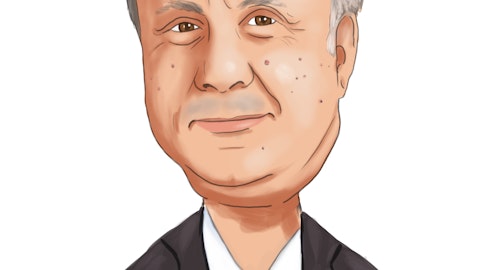Tom Hennigan: So let me tackle the last part first because that’s one of my favorite questions or answers. That company has exhibited 12 consecutive quarters of EBITDA growth, steady performance, continued upward trend, modest increases every quarter, but 12 quarters in a row coming out of the pandemic of EBITDA increases. In terms of the future, it’s stable growth. We’re not looking to shoot for the fences and get — and put in material new dollars to grow it. We’re going now as the new equity group assess the right time to exit the investment. We’re going to invest prudently. We don’t have any grand plans. The company’s performance, it’s stable and improving, and we’ll look at the right time to exit the investment.
Aren LeeKong: And Fin, it’s a good question. I think where we are in the cycle, we here at Carlyle Direct Lending spent a lot of time a year-plus ago, I think it was behind the scenes, looking at our processes, figuring out exactly how to be prudent and more careful in terms of, again, being proactive in situations that were teetering. So I would say that we’re kind of — we’re not in the first inning of that for our portfolio. We’re close to the end of the game and we have full control of it. I think a lot of our peers are just on the front end of that. So for us, part of the boring stuff is you’re not going to — Tom is not going to be in front of the Street, like we are today saying, “hey, we’ve turned the corner” without those 12 consecutive quarters of positive numbers. So for us, the key isn’t — the key is to making sure that we have a clean portfolio when we come to you, and we’re being conservative. So we feel pretty good about where things are.
Operator: And our next question comes from the line of Arren Cyganovich from Citi.
Arren Cyganovich: A question on maybe just the competitive dynamics as the activity increased.
Aren LeeKong: Arren, do you mind — we can’t — you’re a little muffled.
Arren Cyganovich: I’m muffled. Sorry. Is it better?
Aren LeeKong: Sure.
Arren Cyganovich: Sorry about that. I guess from a competitive standpoint, as activity is increasing or hearing spreads are tightening a bit, how is that changing, I guess, relative to maybe three or six months ago?
Aren LeeKong: Yes. I’ve listened to a few of our peers’ calls, and that seems to be a common question. So I’ve been saying this a lot recently, this time isn’t different. Usually when you’re getting outsized returns just what we learned in Economics 101 as capital comes in to try to attract those outsized returns, and that’s what gets the spreads to go back to normal. I would say that relative to first quarter and first half of last year where — and again, I’m giving you directional numbers. I actually don’t have them off the top of my head. So the average deal we’re seeing was probably close to 675, 700, that’s not normal. So relative to an abnormally wide spread and, quite frankly, a very high base rate where base returns were going to be 13% plus, things have come in significantly since then.
I’d say at the upper end of the market, if you are talking about a transaction that is north of $100 million and could easily be considered for the BSL market in a previous life, those transactions have certainly gone from north of 600 to somewhere between the larger end 500 and up to 550. For a regular way direct lending deal that is mid-market, what we’re seeing is somewhere between 550 and 625 on average. So those have come in. With that said, with base rates still where they are, you are achieving sort of a historic level of return without much leverage. And what you haven’t seen or at least we’ve been — we try to be disciplined here. But what you’re seeing on the upper part of the market, certainly, covenants have look a lot or covenant — the existence of covenants looks a lot more like the BSL market there.
So there’s a lot more cov-light in the upper end of the direct lending market. In the regular way mid-market, I’d say more times than not, you’re seeing your covenants, and then the documentation is still holding in. I’d also say what else is holding in is leverage levels. So just because of the overall — even if spreads have come in, you’re still talking about a 530 base rate, give or take. So the average leverage level that we’re seeing hasn’t really increased much. You’re still talking about low 5s and in some cases, high 4s. So you’re still seeing a fairly low amount of leverage. So what I’d say is dependent on where you are and this goes to the previous person’s — the previous analyst question, that’s why we’re opportunistic as to where we play.
There are certain times — certain parts of the market that are much more competitive and aggressive. And we at times avoid those so that we can actually get overpaid in other parts of the market. I would say the larger market is probably the most competitive today. We have stated that things are — and that’s why we’re being a little bit more opportunistic. The mid-market, I think you’re seeing a little bit more value there, more likelihood of covenants, more likelihood of stronger documentation. And I’d say for all of the market, not just the mid-market, I’d say the leverage levels are continuing to be lower than historical leverage levels. Does that work, Arren?
Arren Cyganovich: Yes. Perfect. And then just a quick one on your other income. I think you said that, that was up kind of quarter-to-quarter due to prepayment activity happening. We see more prepayment fees. Do you expect that your other income might — if you look back to more of your longer-term historical in this kind of environment? Or would that be expected to come back down kind of where it was over the past three preceding quarters?




